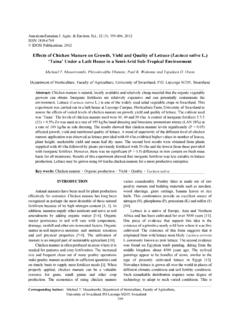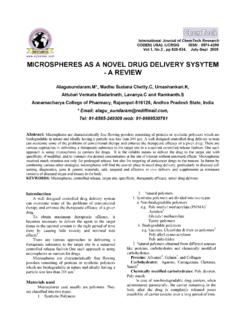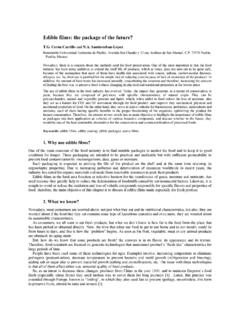Transcription of Applications of Chitosan and Chitosan Derivatives …
1 Advances in Biological Research 5 (1): 28-37, 2011 ISSN 1992-0067 IDOSI Publications, 2011 Corresponding Author:Vipin Bansal, Department of Pharmaceutical Technology, Meerut Institute of Engineeringand Technology, Baghpat Crossing, NH-58, Meerut-250005, : +91 9639435888, E-mail: of Chitosan and Chitosan Derivatives in Drug DeliveryVipin Bansal, Pramod Kumar Sharma, Nitin Sharma, Om Prakash Pal and Rishabha MalviyaDepartment of Pharmaceutical Technology, Meerut Institute of Engineering andTechnology Baghpat Crossing, NH-58, Meerut-250005, IndiaAbstract: Chitosan is a versatile natural polymer. This article reviewed different aspects of Chitosan that sincluding preparation and characterization of Chitosan with their applicability in pharmaceutical , the article included different Derivatives of Chitosan and their use in different drug delivery review emphasized that research on Chitosan based systems containing various drugs for varioustherapeutic Applications have increased in recent years.
2 So this article has fullfill the requirement of a reviewon this naturally derived polymer in present words: Chitosan Chitosan derivative Pharmaceutical Applications Natural polymerINTRODUCTIONin the exoskeleton of crustaceans (crabs, shrimp, etc.).Polymers are macromolecules composed of repeatingit acts as a copolymer of varying amounts of N-acetylstructural units of monomers connected by covalentglucosamine and N-glucosamine repeated units. Thechemical bonds and this process is known aspresence of reactive primary amino groups renderspolymerization. There are many types of polymersspecial property that makes CS very useful inincluding natural and synthetic moiety.
3 Natural polymerspharmaceutical Applications . Commercially availablesuch as proteins (collagen, silk and keratin),CS has an average molecular weight ranging betweencarbohydrates (starch, glycogen) are widely used3800 and 20,000 Daltons and is 66 to 95% for conventional and novel dosage solubility of CS depend on the degree ofThese materials are chemically inert, nontoxic, lessdeacetylation, pH and on the protonation of freeexpensive, biodegradable, eco-friendly and widelyamino groups. CS is readily soluble in dilute solutions ofavailable [1, 2]. The development of new applicationsmost of the organic acids such as citric, tartaric acid, whilefor Chitosan and its derivative is mainly due to the factsoluble to a limited extent in inorganic acids [3].
4 CS has athat these are renewable source of natural biodegradablelarge number of Applications in pharmaceutal dosagepolymers and also due to chitin and its derivative are theform; its further application can be exploited bymost abundant natural polymers. The main factors whichmodifications of basic structure to obtain polymers withstimulated the interest in Chitosan utilization in variousa range of properties. It can be done by number offields from fertilizers to pharmaceuticals are its versatility,approaches such as chemically as well as byeconomical and easily availability. Chitosan is no longerenzymatically. CS can be modified in to N-trimethylenejust a waste by-product from the seafood processingchloride, which is a quaternary derivative of CS and hasindustry.
5 This material is now being utilized by industrya superior aqueous solubility, intestinal permeability asto solve problems and to improve existing products, aswell as higher absorption of neutral and cationic peptidewell as to create new ones. Chitosan (CS) is modifiedanalogue over a wide pH range [4]. It can be modified innatural, biodegradable, biocompatible, non toxic, as wellto an ester form such as CS glutamate, CS succinate, CSas linear nitrogenous polysaccharides, a basicphthalate. These CS esters have a different solubilitypolysaccharide homo-polymer [2]. CS is producedprofile. These esteric forms were insoluble in acidiccommercially by deacetylation of chitin, naturallycondition and provide sustained release in basicoccurring polysaccharides which is the structural elementcondition [5].
6 Due to variable and incomplete deacetylation process,Advan. Biol. Res., 5 (1): 28-37, 201129 This article discussed the structure characteristics, Derivatives of Chitosan (CS): CS has a large no. ofphysiochemical and biological properties, its effect onapplication in pharmaceutal dosage form; its furtherpharmacokinetic release of drugs and its Applications inapplication can be exploited by modification of basicvarious dosage forms through various to obtain polymers with a wide range ofHistory of Chitosan : The history of CS was started whenRouget discussed the deacetylated form of Chloride Chitosan : N-trimethyleneDifferent researchers have been discussed the need ofchloride (TMC)is a quaternary derivative of CSunderstand and studying these materials, from betterand it has a superior aqueous solubility, intestinalproduction, purification methods, to the modificationspermeability as well as higher absorption over a wideof basic structure and its Applications .
7 CS has beenpH range. The TMC polymer is designated according toregarded as a source of potential bioactive material, buttheir degree of methylation such as TMC-20%, TMC-40%it also has several limitations to be utilized in biologicaland TMC-60%. The TMC with high degrees ofsystem, including its poor solubility under physiologicalsubstitution, decrease in solubility has been Therefore, to overcome these limitations,Hammanet al.[4] demonstrated that quaternization ofresearchers focused on the derivatization of CS byTMC decreases the transepithelial electrical resistancechemical modifications and partially hydrolyzed CS byand thereby influences its drug absorption-enhancingenzymatic actions as it contains various groups.
8 Chemical modifications of CSstructures results in increased solubility in water as wellChitosan Esters: CS (glutamate, succinate, phthalate)as in organic solvents have been reported by someesteric forms have a different solubility profile. Theseresearchers. Partially hydrolyzed CS by enzymaticesteric forms were insoluble in acidic condition andmethods results in enhanced significant properties [6].provide sustained release in basic condition. CS estersFurther preparation and Derivatives of Chitosan arebased matrix been used successfully in many formulationscovered by fallowing points given below:such as in colon-specific oral delivery of sodiumPreparation of Chitosan (CS) from Raw Materials: CS isnot a single chemical entity, but varies in compositionChitosan Conjugates: CS can be conjugate with adepending on the source and method of preparationbioactive excepients for delivery of active ingredientsand also on physiological conditions.
9 CS could besuch as calcitonin. CS conjugates such as 5-defined as sufficiently deacetylation of chitin to form amethylpyrrolidinonechitosan, Chitosan -4-soluble amine salts. The degree of deacetylation must bethiobutylamidine conjugate have shown enhanced80 to 85% or higher or the acetyl content must be lessabsorption as well as mucoadhesives 4- to form the soluble product. CS isGuggi and Bernkop [8] attached an enzyme inhibitor tomanufactured commercially by a chemical The resulting polymer retained the mucoadhesiveFirstly the sources such as crab or shrimp shells areproperties and furthermore an attached enzyme inhibitorwashed and grinded in to powdered form and then it isprevents the degradation of drugs by inhibiting enzymes,deproteinized by treatment with an aqueous 3-5% solutionsuch as trypsin and chymotrypsin.
10 This conjugated CSof sodium hydroxide. After that it is neutralized anddemonstrated promise delivery of sensitive peptidedemineralized at a room temperature by treating it withdrugs, such as 3-5% of hydrochloric solution to form a white orslightly pink precipitate of chitin. Then chitin isProperties of Chitosan : Chemistry: CS is a lineardeacetylated by treatment with an aqueous 40-45% ofrandomly distributed, hetero polysaccharide consistingsodium hydroxide solution and the precipitate is thenof (1-4) linked 2-acetamido-2-deoxy--D-glucopyranosewash ed with water. The insoluble part is removed byand 2-amino-2-deoxy--Dglycopyranose units (Fig. 1).dissolving in an aqueous 2% acetic acids solution.
















